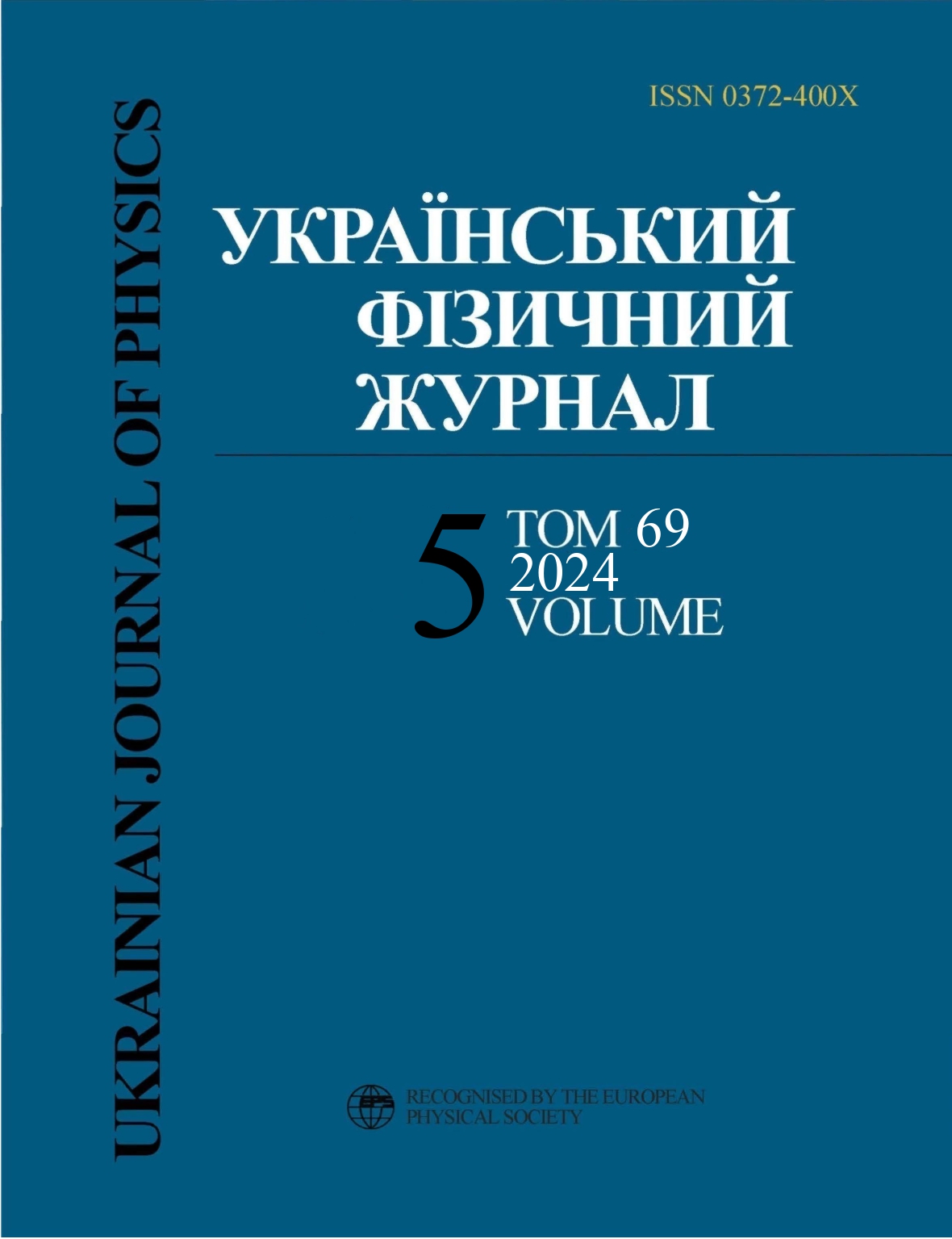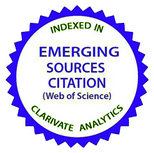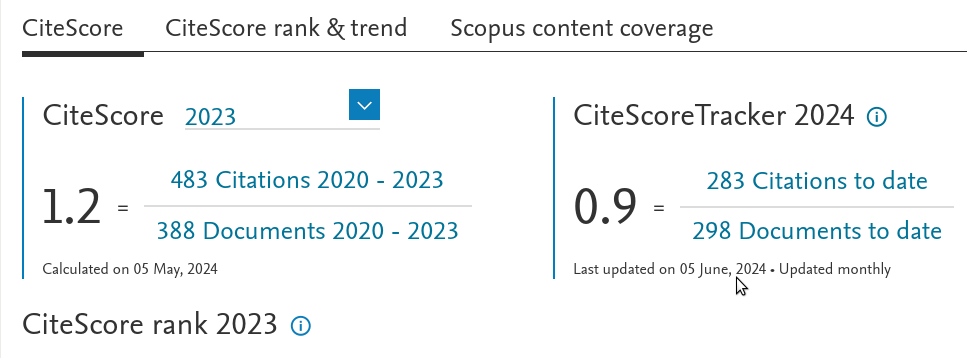Дослідження тонкого налаштування оптичної забороненої зони і різних оптичних параметрів зміною вмісту гадолінію в NGFO феритових наночастинках
DOI:
https://doi.org/10.15407/ujpe69.5.304Ключові слова:
NGFO наночастинки, оптична заборонена зона, показник заломлення, коефiцiєнт поглинання, втрати при вiдбиттi, оптична дiелектрична константаАнотація
За допомогою золь-гель методу автоспалення отримано наночастинки фериту з нiкелем i гадолiнiєм, що має склад NiFe2−xGdxO4 (X = 0, 00, 0,05, 0,10, 0,15, 0,20, та 0,25), I кальциновано зразки при 700 ∘C. Рентґенограми свiдчать про формування фази зi структурою шпiнелi. Для всiх зразкiв спостерiгається пiк поглинання бiля 250–300 нм. Використовуючи дiаграми Таука i данi рентґеноструктурного аналiзу, ми знайшли, що ширина оптичної забороненої зони дорiвнює, вiдповiдно, 4,033–4,144 еВ та 3,69–4,3 еВ. Знайдено, що цей та iншi оптичнi параметри залежать вiд вмiсту гадолiнiю.
Посилання
L. Jaswala, B Singh. Ferrite materials: A chronological review. J. Integr. Sci. Technol. 2, 69 (2014).
S. Yadav. Development of a low loss Mn-Zn Ferrite Material for power applications. (2006).
G. Rana, P. Dhiman, A. Kumar, D.V.N. Vo, G. Sharma, S. Sharma, M. Naushad. Recent advances on nickel nanoferrite: A review on processing techniques, properties and diverse applications. Chem. Eng. Res. Des. 175, 182 (2021).
https://doi.org/10.1016/j.cherd.2021.08.040
W.A. Khoso, N. Haleem, M.A. Baig, Y. Jamal. Synthesis, characterization and heavy metal removal efficiency of nickel ferrite nanoparticles (NFN's). Sci. Rep. 11 (1), 1 (2021).
https://doi.org/10.1038/s41598-021-83363-1
G.N. Rajivgandhi, G. Ramachandran, C.C. Kanisha, N.S. Alharbi, S. Kadaikunnan, J.M. Khaled, K.F. Alanzi, W.J. Li. Effect of Ti and Cu doping on the structural, optical, morphological and anti-bacterial properties of nickel ferrite nanoparticles. Results Phys. 23, 104065 (2021).
https://doi.org/10.1016/j.rinp.2021.104065
J. Hwang, M. Choi, H.-S. Shin, B.-K. Ju, M. Chun. Structural and magnetic properties of NiZn ferrite nanoparticles synthesized by a thermal decomposition method. Appl. Sci. 10 (18), 6279 (2020).
https://doi.org/10.3390/app10186279
B. Hussain. Synthesis, Characterization and Antibacterial Study of Silver Doped Manganese Ferrite Nanocomposites. MS & PhD Thesis (2021).
H. Du, O.U. Akakuru, C. Yao, F. Yang, A. Wu. Transition metal ion-doped ferrites nanoparticles for bioimaging and cancer therapy, Transl. oncol. 15 (1), 101264 (2022).
https://doi.org/10.1016/j.tranon.2021.101264
S. Naik, A. Salker. Change in the magnetostructural properties of rare earth doped cobalt ferrites relative to the magnetic anisotropy. J. Mater. Chem. 22 (6), 2740 (2012).
https://doi.org/10.1039/C2JM15228B
R.J. Elliott. Magnetic Properties of Rare Earth Metals (Springer, 2013).
R. Moon, W. Koehler, J. Cable, H. Child. Distribution of magnetic moment in metallic Gadolinium. Phys. Rev. B 5, 997 (1972).
https://doi.org/10.1103/PhysRevB.5.997
F. Cheng, C. Liao, J. Kuang, Z.Xu, C. Yan, L. Chen, H. Zhao, Z. Liu. Nanostructure magneto-optical thin flms of rare earth (RE = Gd, Tb, Dy) doped cobalt spinel by sol-gel synthesis. J. Appl. Phys. 85, 2782 (1999).
https://doi.org/10.1063/1.369594
S. Mahalakshmi, K. Srinivasa Manja, S. Nithiyanantham. Electrical properties of nanophase ferrites doped with rare earth ions. J. Supercond. Nov. Magn. 27, 2083 (2014).
https://doi.org/10.1007/s10948-014-2551-y
M.S.S. Adam, A.M. Hafez, M.M. Khalaf. Rare earth Ceand Nd-doped spinel nickel ferrites as effective heterogeneous catalysts in the (ep) oxidation of alkenes. J. Iran. Chem. Soc. 17 (12), 3237 (2020).
https://doi.org/10.1007/s13738-020-01983-2
C.S. Pawar, M.P. Gujar, V.L. Mathe. Optical properties of spin-deposited nanocrystalline Ni-Zn ferrite thin films processed by sol-gel. J. Supercond. Nov. Magn. 30, 615 (2017).
https://doi.org/10.1007/s10948-016-3720-y
V. Dimitrov, T. Komatsu. An interpretation of optical properties of oxides and oxide glasses in terms of the electronic ion polarizability and average single bond strength, J. Univ. Chem. Technol. Met. 45, 219 (2010).
M.K. Halimah, M.F. Faznny, M.N. Azlan, H.A.A. Sidek. Optical basicity and electronic polarizability of zinc borotellurite glass doped La3+ ions. Results Phys. 7, 581 (2017).
https://doi.org/10.1016/j.rinp.2017.01.014
G. Rana, P. Dhiman, A. Kumar, D.V.N. Vo, G. Sharma, S. Sharma, M. Naushad. Recent advances on nickel nanoferrite: A review on processing techniques, properties and diverse applications. Chem. Eng. Res. Des. 175 (12), 182 (2021).
https://doi.org/10.1016/j.cherd.2021.08.040
K. Rama Krishn, K. Vijaya Kumar, D. Ravinder. Structural and electrical conductivity studies in nickel-zinc ferrite. Adv. Mater. Phys. Chem. 2, 185 (2012).
https://doi.org/10.4236/ampc.2012.23028
K.V. Kumar, S.D. Bhavani. Influence of calcination temperature on physical and optical properties of nickel chromite nanoparticles. Science of Sintering 54 (4), 457 (2022).
https://doi.org/10.2298/SOS2204457K
K.V. Kumar, S.D. Bhavani. Impact of calcination temperature on structural and optical properties of erbium-doped zinc ferrite nanoparticles. Phase Transitions 95 (11), 770 (2022).
https://doi.org/10.1080/01411594.2022.2117622
Sara Durga Bhavani, K. Vijaya Kumar. Effect of calcination temperature on structural and optical properties of nickel aluminate nanoparticles. East Eur. J. Phys. 3, 355 (2023).
https://doi.org/10.26565/2312-4334-2023-3-37
Sara Durga Bhavani, A.T. Raghavender, K. Vijaya Kumar, B. Purna Chandra Rao. Effect of annealing temperature on the XRD and IR properties of Gd doped nickel ferrites nanoparticles. Eur. Chem. Bull. 12 (4), 10479 (2023).
K.V. Kumar. Tunable optical bandgap of gadolinium substituted nickel-zinc ferrite nanoparticles, effect of calcination temperature on its optical parameters. Adv. in Mater. Phys. Chem. 12, 33 (2022).
https://doi.org/10.4236/ampc.2022.123003
A. Korsakov, D. Salimgareev, A. Lvov, L. Zhukova. IR spectroscopic determination of the refractive index of Ag1−xTlxBr1−0.54xI0.54x (0 ≤ x ≤ 0.05) crystals. Opt. Laser Technol. 93, 18 (2017).
https://doi.org/10.1016/j.optlastec.2017.01.030
B. Joseph, P.K. Manoj, V.K. Vaidyan. Studies on the structural, electrical and optical properties of Al-doped ZnO thin films prepared by chemical spray deposition. Ceram. Int. 32, 487 (2006).
https://doi.org/10.1016/j.ceramint.2005.03.029
A. Fadhalaoui, S. Kouass, H. Dhaouad. BixCe1−xPO4 (x = 0.00, 0.02, and 0.08) nanorods: Structural, electrical, optical, and electrochemical properties. Ionics 24, 429 (2018).
https://doi.org/10.1007/s11581-017-2222-7
K. Sampath, D.G. Kanhere, R. Pandey. Electronic structure of spinel oxides: Zinc aluminate and zinc gallate. J. Phys. Condens. Matter. 11, 3635 (1999).
https://doi.org/10.1088/0953-8984/11/18/301
O.L. Anderson, E. Schreiber. The relation between refractive index and density of minerals related to the Earth's mantle. J. Geophys. Res. 70 (6), 1463 (1965).
https://doi.org/10.1029/JZ070i006p01463
T.S. Moss. Relation between the refractive index and energy gap of semiconductors. Phys. Status Solidi B 131, 415 (1985).
https://doi.org/10.1002/pssb.2221310202
V.P. Gupta, N.M. Ravindra. Comments on the moss formula. Phys. Status Solidi (b) 100 (2), 715 (1980).
https://doi.org/10.1002/pssb.2221000240
P. Herve, L.K.J. Vandamme. General relation between refractive index and energy gap in semiconductors. Infrared Phys. Technol. 35 (4), 609 (1994).
https://doi.org/10.1016/1350-4495(94)90026-4
R.R. Reddy, Y.N. Ahammed, K.R. Gopal, P.A. Azeem, T.V.R. Rao, P.M. Reddy. Optical electronegativity, bulk modulus and electronic polarizability of materials. Opt. Mater. 14, 355 (2000).
https://doi.org/10.1016/S0925-3467(00)00004-5
M. Anani, C. Mathieu, S. Lebid, Y. Amar, Z. Chama, H. Abid. Model for calculating the refractive index of a III-V semiconductor. Comput. Mater. Sci. 41, 570 (2008).
https://doi.org/10.1016/j.commatsci.2007.05.023
N.P. Barde, V.R. Rathod, P.S. Solanki, N.A. Shah, P.P. Bardapurkar. On the structural, refractive index and energy bandgap based optical properties of lithium ferrite nanoparticles dispersed in silica matrix. Appl. Surf. Sci. Adv. 11, 100302 (2022).
https://doi.org/10.1016/j.apsadv.2022.100302
S.K. Tripathy. Refractive indices of semiconductors from energy gaps. Opt. Mater. 46, 240 (2015).
https://doi.org/10.1016/j.optmat.2015.04.026
Z. Serbet¸ci, H.M. Nasser, Yaku Phanoglu. Photoluminescence and refractive index dispersion properties of ZnO nanofibers grown by sol-gel method. Spectrochim. Acta, Part A 86, 405 (2012).
https://doi.org/10.1016/j.saa.2011.10.058
K.B. Modi, S.J. Shah, N.B. Pujara, T.K. Pathak, N.H. Vasoya, I.G. Jhala. Infrared spectral evolution, elastic, optical and thermodynamic properties study on mechanically milled Ni0.5Zn0.5Fe2O4 spinel ferrite. J. Mol. Struct. 1049, 250 (2013).
https://doi.org/10.1016/j.molstruc.2013.06.051
K.B. Modi, P.Y. Raval, P.R. Pansara, I.R. Badi, D.R. Devmurari, S.S. Munshi, P.U. Sharma. On the relationship between structural-optical parameters of Y3−xFe5+xO12 garnet ferrites and the oxide additivity rule. J. Supercond. Nov. Magn. 29, 1931 (2016).
https://doi.org/10.1007/s10948-016-3488-0
R.D. Shannon, R.X. Fischer. Empirical electronic polarizabilities in oxides, hydroxides, oxyfluorides, and oxychlorides. Phys. Rev. B Condens. Matter Mater. Phys. 73, 235111 (2006).
https://doi.org/10.1103/PhysRevB.73.235111
B. Bhatia, S.L. Meena, V. Parihar, M. Poonia. Optical basicity and polarizability of Nd4+-doped bismuth borate glasses. New J. Glass. Ceram. 05, 44 (2015).
https://doi.org/10.4236/njgc.2015.53006
S.A. Umar, M.K. Halimah, K.T. Chan, A.A. Latif. Polarizability, optical basicity and electric susceptibility of Er3+ doped silicate borotellurite glasses. J. Non Cryst. Solids 471, 101 (2017).
Downloads
Опубліковано
Як цитувати
Номер
Розділ
Ліцензія
Ліцензійний Договір
на використання Твору
м. Київ, Україна
Відповідальний автор та співавтори (надалі іменовані як Автор(и)) статті, яку він (вони) подають до Українського фізичного журналу, (надалі іменована як Твір) з одного боку та Інститут теоретичної фізики імені М.М. Боголюбова НАН України в особі директора (надалі – Видавець) з іншого боку уклали даний Договір про таке:
1. Предмет договору.
Автор(и) надає(ють) Видавцю безоплатно невиключні права на використання Твору (наукового, технічного або іншого характеру) на умовах, визначених цим Договором.
2. Способи використання Твору.
2.1. Автор(и) надає(ють) Видавцю право на використання Твору таким чином:
2.1.1. Використовувати Твір шляхом його видання в Українському фізичному журналі (далі – Видання) мовою оригіналу та в перекладі на англійську (погоджений Автором(ами) і Видавцем примірник Твору, прийнятого до друку, є невід’ємною частиною Ліцензійного договору).
2.1.2. Переробляти, адаптувати або іншим чином змінювати Твір за погодженням з Автором(ами).
2.1.3. Перекладати Твір у випадку, коли Твір викладений іншою мовою, ніж мова, якою передбачена публікація у Виданні.
2.2. Якщо Автор(и) виявить(лять) бажання використовувати Твір в інший спосіб, як то публікувати перекладену версію Твору (окрім випадку, зазначеного в п. 2.1.3 цього Договору); розміщувати повністю або частково в мережі Інтернет; публікувати Твір в інших, у тому числі іноземних, виданнях; включати Твір як складову частину інших збірників, антологій, енциклопедій тощо, то Автор(и) мають отримати на це письмовий дозвіл від Видавця.
3. Територія використання.
Автор(и) надає(ють) Видавцю право на використання Твору способами, зазначеними у п.п. 2.1.1–2.1.3 цього Договору, на території України, а також право на розповсюдження Твору як невід’ємної складової частини Видання на території України та інших країн шляхом передплати, продажу та безоплатної передачі третій стороні.
4. Строк, на який надаються права.
4.1. Договір є чинним з дати підписання та діє протягом усього часу функціонування Видання.
5. Застереження.
5.1. Автор(и) заявляє(ють), що:
– він/вона є автором (співавтором) Твору;
– авторські права на даний Твір не передані іншій стороні;
– даний Твір не був раніше опублікований і не буде опублікований у будь-якому іншому виданні до публікації його Видавцем (див. також п. 2.2);
– Автор(и) не порушив(ли) права інтелектуальної власності інших осіб. Якщо у Творі наведені матеріали інших осіб за виключенням випадків цитування в обсязі, виправданому науковим, інформаційним або критичним характером Твору, використання таких матеріалів здійснене Автором(ами) з дотриманням норм міжнародного законодавства і законодавства України.
6. Реквізити і підписи сторін.
Видавець: Інститут теоретичної фізики імені М.М. Боголюбова НАН України.
Адреса: м. Київ, вул. Метрологічна 14-б.
Автор: Електронний підпис від імені та за погодження всіх співавторів.

















